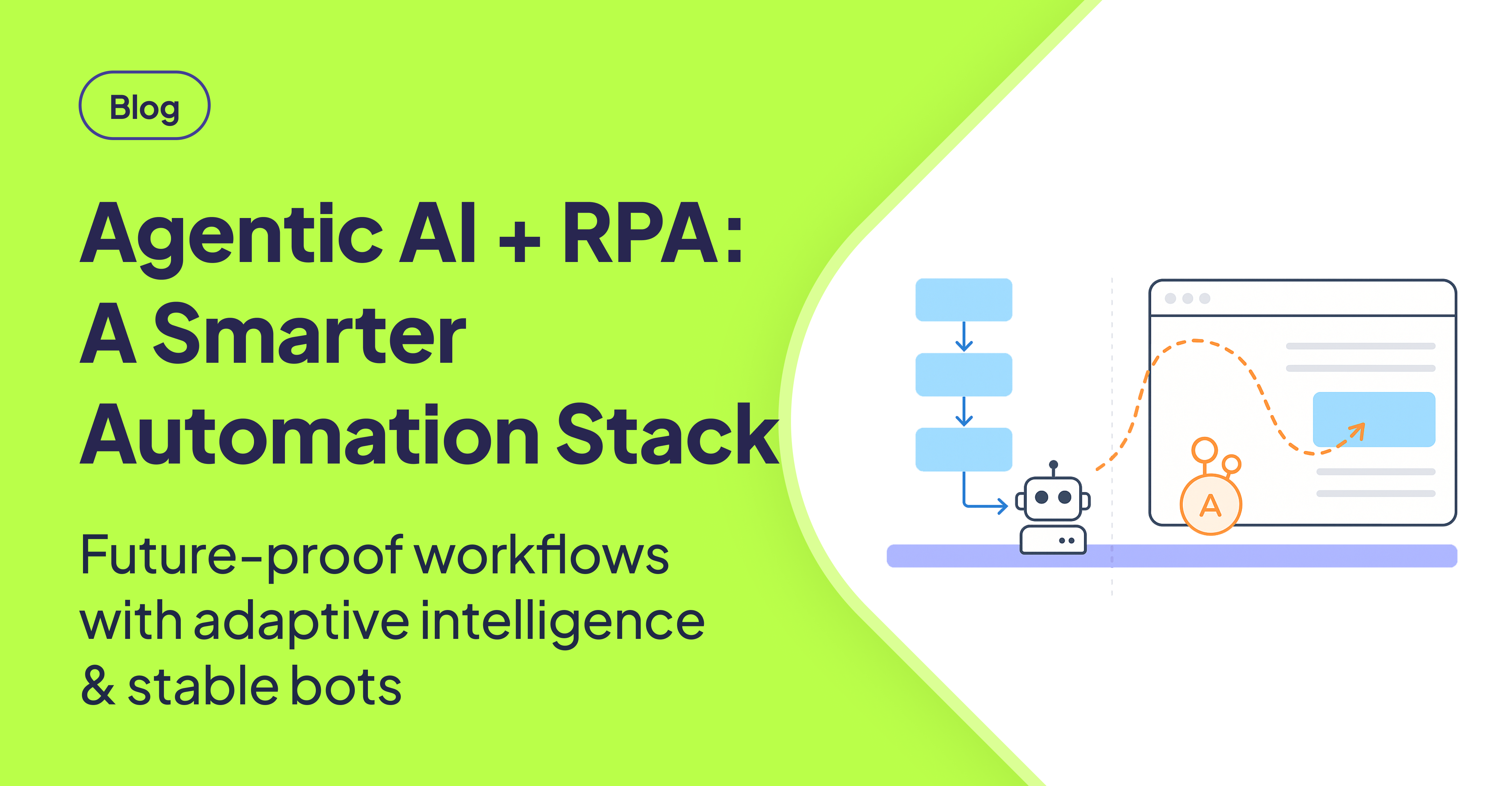TLDR
Combining Agentic AI with RPA creates a more robust automation strategy. RPA handles structured, repetitive tasks efficiently, while Agentic AI provides the adaptability to navigate dynamic, visually complex, and multi-platform environments. This synergy reduces failures, lowers maintenance, and extends automation to previously inaccessible applications.
Introduction
Software teams are under constant pressure to deliver faster releases, integrate fragmented systems, and control rising maintenance costs. Traditional RPA solutions often falter when confronted with frequent UI changes and processes that span multiple platforms. Agentic AI offers a powerful solution by introducing adaptive, context-aware automation that complements traditional RPA, ensuring that automation initiatives remain effective even as applications evolve. This approach builds a more resilient and maintainable automation ecosystem.
The Foundation of Stability
Understanding Agentic AI and Its Edge Over RPA
Agentic AI employs goal-driven intelligent agents that visually interpret interfaces and make real-time decisions, mimicking human interaction. Unlike traditional RPA, Agentic AI relies on visual and contextual cues, allowing it to dynamically adapt to UI changes and seamlessly navigate across diverse environments, including web, desktop, and virtual platforms. Traditional RPA, which depends on static selectors, often struggles with dynamic UIs. [STAT: According to a recent industry report, over 40% of RPA implementations fail due to unexpected UI changes.]
Here's a comparative overview:
| Feature | Agentic AI (e.g., AskUI) | Traditional RPA |
|---|---|---|
| Decision-making | Contextual, dynamic | Rule-based, static |
| UI handling | Visual, cross-platform | DOM/xPath or selectors, limited |
| Resilience | Self-adjusts to UI changes | Prone to breaks, needs script fixes |
| Coverage | Hybrid apps, Citrix, VDI included | Mostly structured apps only |
Building Resilient Workflows
The Synergistic Benefits of Combining Agentic AI with RPA
Agentic AI and RPA are complementary technologies that, when combined, create a more powerful automation solution. RPA is ideal for stable, repetitive tasks, while Agentic AI excels at handling exceptions and navigating dynamic environments. [STAT: Companies that integrate AI into their automation processes experience a 30% reduction in error rates compared to those relying solely on RPA.] By integrating the two technologies, you achieve:
- Efficient management of structured back-office workflows through RPA.
- Seamless handling of UI variability or multi-platform processes using Agentic AI.
- Reduced failures and manual interventions, ensuring a consistent automation pipeline.
Real-World Application: A Use Case Example
Consider a QA team at a financial institution using RPA for standard customer onboarding data entry. When an unexpected UI change occurs during a website update, their Agentic AI layer dynamically recognizes the new layouts and keeps workflows running, avoiding costly delays and maintaining operational efficiency.
Advanced Techniques
Identifying Optimal Integration Scenarios
Consider integrating Agentic AI with RPA in the following scenarios to maximize benefits:
- Rapidly changing UIs: Ideal for SaaS platforms with frequent updates. [STAT: SaaS applications experience UI updates on average every 2-4 weeks, frequently breaking traditional RPA scripts.]
- Hybrid or multi-platform processes: Critical for workflows spanning desktop, browser, and mobile applications.
- Critical operations: Essential where automation failures could significantly impact revenue or customer experience.
- Reducing script maintenance: Allows visual AI agents to adapt on the fly, reducing the burden on development teams.
Many teams begin by layering Agentic AI tools on top of existing RPA to address their most fragile or business-critical automations, showcasing a practical and phased approach to integration.
Weighing the Pros and Cons
| Pros | Cons |
|---|---|
| Strengthens automation resilience | May need initial integration effort |
| Reduces manual script maintenance | Could require upskilling teams |
| Extends coverage to complex environments | Slightly higher upfront investment |
| Future-proofs against UI volatility |
Conclusion
Combining Agentic AI with RPA provides a smarter, more resilient, and future-proofed automation strategy. The synergy of these tools can transform team operations by reducing manual maintenance, tackling complex multi-platform workflows, and adapting to rapidly changing UI environments. By embracing Agentic AI alongside RPA, organizations can ensure their automation initiatives remain effective and adaptable in the face of evolving technological landscapes.
FAQ
Why pair Agentic AI with RPA instead of relying on one?
Agentic AI excels at handling variability and unexpected UI changes, while RPA excels at structured, rule-driven workflows. Combining them balances adaptability with efficiency, creating a more robust automation solution.
What types of teams benefit most from this approach?
Teams managing hybrid environments, frequent UI updates, or needing to automate Citrix/VDI scenarios typically gain the most from layering Agentic AI with existing RPA. These environments pose significant challenges for traditional RPA alone.
How does this reduce maintenance overhead?
Agentic AI dynamically adapts to interface changes, cutting down the frequent script reworks often required by traditional RPA alone. This self-healing capability significantly reduces the burden on development teams.
Is it possible to pilot this on a small process first?
Absolutely. Many organizations start by integrating Agentic AI into a single fragile workflow before scaling across broader operations. This allows teams to assess the benefits and fine-tune their integration strategy.
Can it extend automation to previously 'untestable' apps?
Yes. Visual AI enables automation even where traditional RPA selectors fail, such as in legacy desktop apps or virtualized environments. [STAT: Agentic AI can automate up to 70% of tasks previously considered impossible to automate using traditional RPA methods.] This opens up new possibilities for automation across the enterprise.
